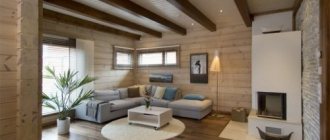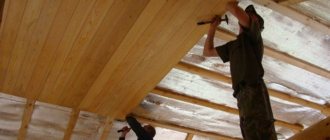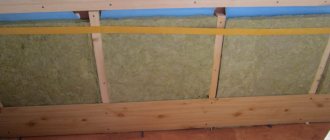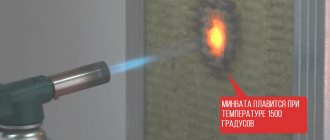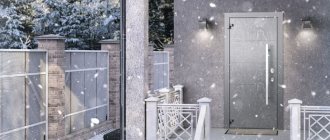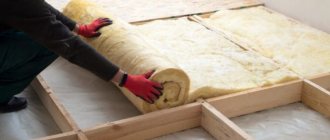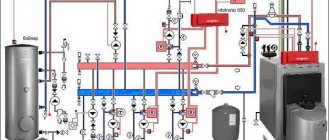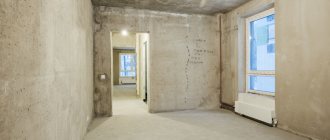During the construction or renovation of housing, the owners are faced with a dilemma: save on thermal insulation and subsequently spend significant funds on heating, or still insulate and live in comfortable conditions with minimal expenditure on heating from the family budget.
Insulation needs to start from the ceiling. There are several reasons:
- heat loss through 1 m2 of ceiling is several times higher than that of walls, firstly, due to the fact that the ceiling is much thinner, and secondly, warm air rises, as a result of which heat transfer by ceiling structures from inside to outside is carried out much more more intense;
- On an uninsulated ceiling with a cold roof (sometimes called ventilated), condensation occurs intensively. And this is dampness, mold and mildew.
You can insulate the ceiling with a variety of thermal insulation materials, from purchased ones to improvised ones, such as moss, foliage, straw, reeds, etc. Continuing the series of articles on the StroyGuru portal about insulating different building structures with various insulation materials, in this work we will talk about how to properly insulate a ceiling with mineral wool.
Selection of mineral wool
Among materials for insulation, mineral wool is in increasingly growing demand. This is no coincidence. Let's start with the fact that this is an environmentally friendly material, safe for the environment and humans. Mineral wool has a high heat retention class, absorbs sounds well, is not afraid of rotting, open fire, and is not interesting to rodents and insects. Increased elasticity and dimensional stability predetermine easy installation without fasteners. Mineral wool does not break, crumble, or slide over time, providing reliable thermal protection for up to 50 years.
These characteristics are fully inherent in insulation based on Izover Profi mineral wool. It consists of long slabs in rolls, which are equally suitable for the entire house - ceiling, walls, flat (in frame structures) and pitched roofs (attics), balconies, interior partitions, ceilings above the basement. The improved thermal conductivity coefficient (0.037) will save up to 67% on heating costs when compared with uninsulated spaces. As is known, ordinary mineral wool suffers even when slightly wet - drops of water displace air from the fibers and are difficult to weather, which can lead to a decrease in thermal insulation properties over time. Thanks to the special AquaProtect technology, Izover Profi repels water well and dries much faster due to optimal vapor permeability.
Insulation with mineral wool
Buy at isover market
A nice bonus is savings on transportation and storage due to the increased compression ratio in the packaging - it can be easily loaded into a passenger car, taking up 3 times less space compared to conventional basalt slabs (35 sq. m Isover Pro versus 6 sq. m of ordinary mineral wool, The same amount can be placed on the roof rack if you load an Isover module from several packages there, compressed with high-strength film at the factory). We will consider insulation technology in detail below.
Advantages and choice of slab thickness
Mineral wool has the following advantages:
- light weight; elasticity; fire resistance; low price; long service life.
The thickness of mineral wool is an important parameter when choosing a material. This indicator depends on the ceiling covering. It also takes into account which method will be chosen to insulate the ceiling with mineral wool.
So, for concrete floors, choose wool with a thickness of at least 10 cm. If there is a heated attic space, insulation with a thickness of 8 cm is used. A pitched type of roof requires the installation of mineral wool 30 cm thick.
Features of ceiling thermal insulation with mineral wool
The stages of insulation and thickness directly depend on which ceiling needs to be insulated: under a heated or unheated room, in contact with external cold (in the attic, attic). In addition, the climatic zone of the region and the building structure (floors, walls) are important. Taking these parameters into account, before calculating the cost of mineral wool insulation, its thickness is selected.
Insulation thickness
For a ceiling inside a heated building, as a rule, 50-100 mm is sufficient, and if the ceiling is directly adjacent to a cold attic or roof covering with a slight slope, it is better to focus on 150-250 mm. In the northern region, this figure will have to be increased to 2 times, but in any case, before making the final choice, you need to check whether the planned insulation thickness meets the requirements of your region (in the next section we will look at how this can be done). In the case of reinforced concrete floors, the recommended value is at least 100-150 mm. The Izover Profi packaging contains two slabs, each 50 mm thick, 1220 mm wide, 4100 mm long, which will allow you to vary the degree of thermal protection at your destination based on one product. There is Izover Profi, already cut in half during production: the package contains 4 long slabs 610 x 4100 x 50 mm.
The Isover smart calculator will help you calculate the quantity and required thickness of the material that is optimal for insulating your home.
Material calculation
The peculiarity of the calculator is that it will help you calculate the required amount of insulation, and at the same time the benefits that await you in the short and long term. You only need to fill in the design parameters of the house, its location (region), heating source, and comfortable temperature. As a result, you will receive a detailed calculation of the cost of thermal insulation and how you will save on heating (monthly and annually) and how quickly you will recoup the costs. For example, just by changing the thickness of mineral wool, you can increase the energy efficiency and comfort of staying in your home: from class B with a layer of 50-150 mm (comfort in the off-season, protection from overheating in summer) to the highest class A+++ (at 200 -250 mm), adopted in Norway and Finland for permanent residence and allowing to minimize heating costs. Using the Isover calculator you can easily calculate the thermal insulation of floors, walls, roofs, ceilings, as well as apartments and balconies. In this case, the calculator will redirect you to the online aggregator, where you can place an order from the official distributor.
Benefits of using mineral wool
When choosing insulation for a residential property, first of all, you need it to be an environmentally friendly, durable and fire-resistant material. The range of heat insulators on the market is huge, but mineral wool meets all of the above requirements. It is ideal for insulating ceilings, walls, flooring and loggias.
Before insulating the ceiling in a house with mineral wool, you need to take into account its main advantages:
- environmentally friendly material that does not emit harmful components;
- insects and rodents do not settle in cotton wool;
- it is not subject to rotting processes;
- excellent fire resistance;
- excellent heat and sound insulation qualities;
- affordable price, so it is available to all categories of consumers.
There are also disadvantages. If you choose stone wool or mineral wool for the ceiling, you need to take into account that these heat insulators strongly absorb moisture, and when they get wet, they will lose their original qualities.
In this case, it all depends on how correctly the installation was done. If the ceiling is improperly insulated with mineral wool in a private house or apartment, it loses up to 40% of its thermal insulation properties during the first year of operation. Therefore, it is important to know how to attach insulation to the ceiling so that you don’t have to redo everything later.
If you use a device called a thermal imager, you can easily and clearly determine whether the thermal insulation is done correctly and whether the installed insulation has already sagged. If the mineral wool has lost its qualities, all heat loss will be shown on the screen in red.
Among the wide range, it is not easy to determine which mineral wool is better for the ceiling in an apartment, and which one is better for insulating a private house. In fact, the easiest way to navigate is by taking into account the type of packaging and layer thickness. Mineral wool in cylinders is used for thermal insulation of ventilation pipes, mats are used for external insulation of foundations and floors in basements, and for residential properties, rolls are the best choice.
As for the required thickness of mineral insulation, it will be different for private houses and apartments. In the first case, this figure should be at least 15 centimeters. For apartments, the thickness of mineral wool for ceiling insulation can be only 5 centimeters, but the material must be purchased with greater density.
Ceiling insulation technology
How to insulate a ceiling correctly? The process of thermal insulation of a ceiling in a wooden house consists of three main stages.
Waterproofing
Since wooden floors and the insulation itself can be damaged by moisture, it is first necessary to prevent their contact with water. To do this, all wooden surfaces are first treated with an antiseptic or a complex fire-bioprotective composition with mandatory drying. Then a vapor-permeable barrier is created under the roof - it will become waterproofing, which, without letting in drops of water from condensation or possible leaks, should freely release steam into a ventilated gap of 40-50 mm. Thus, wind-hydroprotection Izover Vetranet (AM), thanks to its three-layer structure, will reliably protect the structure from external moisture, the building from heat loss (blowing), and will not allow condensation to accumulate due to a special “breathable” membrane between the two protective layers. If you are sure that the roof will be used in a cold version (that is, the attic space is low, suitable only for storage), then you can use Isover Hydranet (D) vapor barrier as a moisture barrier, but do not forget about sufficient ventilation and a high-quality vapor barrier installed with sides of the lower warm floor. If you plan to insulate the roof in the future, then vapor-waterproofing (D) will not suit you and can cause harm; for waterproofing a warm roof, it is permissible to use only a “breathing” membrane - Vetranet (AM). It is waterproof and will last at least 50 years. The roll rolls out from left to right. Laying is carried out from below with an overlap (10-15 cm), a construction stapler will be useful. Easy cutting is ensured by convenient factory markings. To prevent water from leaking in, the joints are sealed with specialized adhesive tapes.
Laying mineral wool
Izover Profi in the 610 by 4100 mm format is ready for installation with a standard frame pitch of 600 mm in clearance. When choosing a product with a width of 1200 mm, you will need to cut the roll in half or to the desired dimensions. With a standard beam spacing, installation does not require fasteners - the long slab stands securely in place without cold bridges for at least 50 years. The product is produced in thicknesses of 100 mm or 50 mm (in a package there are either 2 or 4 slabs), allowing you to change the number of layers depending on the location of the ceiling - under a heated room or under the roof. A prerequisite for proper installation is that the width of the slab should be 1-2 cm wider than the pitch of the rafters/beams. Then it will not sag or, conversely, will not be overly compressed. Long slabs mean fewer gaps, joints, and cracks (after all, they increase heat loss by up to 50%). If necessary, the slabs are cut into the required sheets with a knife with a blade length of 15 cm. As a result, insulating the ceiling with Izover Profi mineral wool will take 2 times less time than installing conventional basalt slabs. And its installation can be carried out by one person per work shift.
Vapor barrier
The ceiling is the most vulnerable place to moisture, because this is where all the steam in the room accumulates. Moisture, as we already know, negatively affects the heat-shielding properties of mineral wool, and the structure itself as a whole. Therefore, after installing thermal insulation, reliable insulation technology requires a sealed vapor barrier layer. The Izover Paranet membrane serves these purposes. It is placed overlapping (10-15 cm), completely covering the mineral wool, attached to the rafters with a construction stapler, and then fixed with pressure bars. The joints are sealed (glued) with special adhesive tape Isover Paranet (CL). As a result, the ceiling will be protected from moisture, as well as from the possible formation of mold and mildew.
Please note that insulation with mineral wool should begin on the side farthest from the exit. Gradually move towards the door. Try to avoid gaps, cracks, and a large number of joints. Bends and pinching are fraught with a decrease in the working thickness of the thermal insulation layer, which can lead to heat loss and further freezing of the structure.
Types of fasteners and technology for fastening mineral wool indoors
Installation of insulation indoors is usually carried out in an apartment. Fastening of mineral wool is carried out in several stages:
Construction of the frame. To do this, you need to install a metal sheathing for the suspended ceiling. The profile of the metal sheathing has standard parameters.
For a wooden frame, boards of 30×100 mm or 40×200 mm are used, based on the weight of the slabs. That is, the heavier they are, the more massive the sheathing will be. The slats need to be fixed with dowels with hangers, in increments of 55-60 cm.
This distance is optimal when laying mineral wool in slabs. Installation of waterproofing material. The film is cut into strips of 65-70 cm, i.e.
slightly more than the width of the intervals between the slats. Nails are used for fastening to a wooden frame, and self-tapping screws for a metal frame. The insulation is laid using two methods - using a construction stapler or using a specialized paste. In parallel, a vapor barrier is installed as the top layer.
The result of high-quality work is a consistently strong “pie” of three layers without gaps between the mineral plates. Drywall is placed on the lower profile, which covers the thermal insulation. After this, you can install lighting fixtures and decorate according to the project.
DIY ceiling insulation
There are three methods of insulation depending on the building design:
- external (from the attic or attic);
- internal (in the presence of high ceilings, since it can take away from 150 to 350 mm of the room’s height);
- combined method (used more often for baths, saunas, where exits and communication openings are provided in the ceiling).
If it is necessary to insulate the space under the summer attic (cold or insufficiently insulated), and the ceiling height is small, it is better to thermally insulate not the ceiling, but the floor in the upper room (make sure in advance that the vapor barrier layer on the ceiling of the warm room is present and sealed). The process follows a pattern already familiar to us. You must first clean the floor and, if necessary, cover it hermetically with a vapor barrier (do not forget to seal the joints with special adhesive tape). Then comes the mineral wool between the additionally installed joists. On top there is a waterproofing film and a subfloor.
Tools and materials
Waterproofing film
For installation work, in addition to the insulation itself, you will need:
- waterproofing and vapor barrier film;
- plastic umbrella dowels;
- profile and hangers for it;
- wooden slats;
- self-tapping screws
Tools you will need are a sharp knife, metal scissors or a jigsaw, and a stapler.
When working with mineral wool, you need to use personal protective equipment - glasses, clothing, a respirator and gloves.
Insulation from the inside
If it is necessary to thermally insulate the ceiling with mineral wool inside the house, we proceed according to the scheme described in the previous chapter, from top to bottom: waterproofing - mineral wool - vapor barrier. Under a heated floor, a minimum layer (100-150 mm) is often sufficient, including for basic sound insulation of rooms (a greater sound insulation effect is achievable if the frame space is completely filled and both sides are covered with sheet panels - GSP and moisture-resistant plywood or OSB). Under a cold floor or attic you will have to construct a serious barrier. The order of work and materials for insulation are the same, from top to bottom: waterproofing membrane - special frame (in the absence of beams) - increased layer of mineral wool (determined by calculation) - vapor barrier on the side of the warm room. After this, the ceiling is covered with any sheet panels (for example, Aqua Strong gypsum board) - now it is ready for finishing work.
Advantages and disadvantages of mineral wool
The quality of insulation depends on the type of raw material. In the production of mineral wool, rock and synthetic binder fillers are used.
Thanks to the components, the material has high strength, low thermal conductivity and advantages such as:
- Fire safety. The material does not burn and does not emit harmful substances when heated.
- Resistant to temperature changes. Cotton wool does not deform when heated/cooled.
- Chemical, biological resistance. Bugs, rodents, and mold do not grow in mineral wool. Fibrous material is difficult to destroy by exposure to alkalis and acids.
- Vapor permeability ensures the free passage of air masses. This is especially important when insulating wooden buildings inside and outside.
- Noise insulation. Fiber insulation absorbs noise well, neither letting it in nor letting it out.
- Easy to install. The products are produced in sheets and rolls - this makes it easier to lay and fasten materials on a plane.
- Versatility. Sheets of products can be attached outside and inside buildings.
- Durability. If the work technology is followed, the insulation will last at least 30 years.
- Cheapness. One of the main advantages of the material. Mineral wool as insulation significantly reduces the cost of current or major repairs.
Another advantage is the light weight of the material. Thanks to this property, mineral wool can be used on dilapidated floors and in apartments - additional insulation with the material does not violate building standards and does not require permits.
The product's disadvantages are minimal:
- When laying out, the material must be protected from water. Cotton wool absorbs moisture well, so water-repellent compounds and high-quality waterproofing are useful.
- Compared to foam plastic and other lightweight materials, mineral wool has more weight.
The disadvantages are offset by the affordable price, practicality and durability of the material. In addition, not every insulation is unpleasant for rodents, like mineral fiber, and this is one of the main conditions for the owner of a private house.
Which ceiling insulation to choose
Glass wool has fibers no more than 14 microns thick. These are tiny glass needles. The main qualities inherent in this type are increased strength and elasticity. It is important to remember that when working with glass wool, it is necessary to use personal protective equipment - a glove, a mask, thick clothing, since glass fiber particles, when they get on the skin, cause irritation.
Another advantage of glass wool is that it can withstand very high (up to 450 degrees) and low (up to 50 degrees) temperatures due to its good thermal conductivity coefficient.
Slag wool is made from blast furnace slag, the maximum fiber thickness of which is no more than 20 microns, and the length is 1.5 mm.
Slag is unstable in an acidic environment, so its use on metal surfaces in construction is limited. The high hygroscopicity characteristic of this type does not allow the use of slag wool for insulating the facades of houses or other external elements, and its fragility does not allow it to be used for insulating pipelines and communication systems.
The maximum temperature that slag wool can withstand is 300 degrees. Increasing the heat above the specified level reduces the physical characteristics of the material. The main advantage of slag wool is that its cost is an order of magnitude lower than other mineral analogues.
Basalt (stone) mineral wool has fibers of the same length and size as slag wool. But this material does not cause allergic reactions or skin irritation and is widely known for its insulating properties. High thermal insulation properties and preservation of the declared characteristics at 1000 degrees of heat and 200 degrees of frost influence the fact that to a greater extent the insulation of ceilings is carried out with stone wool.
Basalt wool is produced in the form of rolls or slabs, which facilitates its installation and prevents deformation. Therefore, it is best to choose this type of mineral wool if you need to insulate the ceiling in a private house.
Advice from an experienced master
When planning to independently insulate ceilings in a wooden house, you should understand that this is a difficult and time-consuming process. Before starting any work, you need to carefully think through everything, calculate and check it. Little things that sometimes seem insignificant can greatly spoil your nerves and mood in the future.
So, insulation of the ceiling in a wooden house can only be carried out when all construction and repair work is completed.
Before starting insulation work, you should carefully check the wooden house for leaks and eliminate all distortions and cracks. If you are lazy and leave some imperfections, you can greatly regret it in the future, because it is through them that heat will leave the house.
If there is an attic floor, the ceiling can be insulated with one layer of insulating material, but the attic itself will need to be insulated.
The final finishing can be done on insulation, but to make it better quality, it is still better to cover it with insulation boards or plywood sheets.
Characteristics and manufacturers
Mineral wool is a heat-insulating material with a fibrous structure. Based on the main natural component, the following types of insulation are distinguished:
- Basalt (stone). The basis is rock melts erupted from the depths. The composition includes gabbro or diabase, mixture. Mineral filler – dolomite, limestone, clay. Additives are needed to ensure product fluidity. The binder is a formaldehyde substance made from resins (no more than 2.5-10%).
- Slag. The basis is melted blast furnace slag. It has a fine-fiber structure (thickness 4-12 microns). Waste from blast furnaces during iron smelting is used as slag. This base ensures high strength of the material.
- Glass. The basis is melts of glass, sand, broken glass. Fillers: dolomite, soda, limestone, borax. The material has high hydrophobic properties and is durable and resistant to stress.
Component ratio: 80% – natural materials, 20% synthetic binder.
Product labeling depends on the density of the insulation:
- P-75. Cotton wool density 75 kg/m3. Application: insulation of external horizontal surfaces, pipelines, heating networks and other highways.
- P-125. Density 125 kg/m3. Application: insulation of unloaded surfaces of any location, floors, ceilings. Insulation is also used as a middle layer in three-layer wall panels of low-rise buildings made of brick, gas, foam, and expanded clay concrete.
- PZh-175. Scope of application: insulation of walls, ceilings made of profiled metal sheets, reinforced concrete structures.
- PPZh-200. The scope of application is the same as that of the PZh-175 brand with additional provision of fire resistance of engineering and building structures.
Pros and cons of insulating the ceiling with expanded clay in a private wooden house
Depending on the shape of the material, the characteristics and scope of application of the product differ:
- basalt slabs have a high density and are used in areas with increased load, under concrete screeds;
- roll products are indicated for insulation of unloaded structures;
- Stitched mineral wool mats have found application in insulating the surfaces of production equipment with temperatures up to 400 C.
Established characteristics of mineral wool:
- Strength. 0.08-0.6 kg/cm2. The brand of insulation matters.
- Density. 35-100 kg/m3. The average size is 0.6 m2, low weight facilitates the installation of insulation.
- Shrinkage. It is negligible and does not amount to a fraction of a percent. The indicator guarantees long-term preservation of the positive properties of the product: fire resistance, sound absorption.
- Thermal conductivity. The average coefficient is calculated based on density indicators and is 0.036-0.060 W/mG. During the first years of operation, due to moisture absorption, thermal conductivity can increase up to 50%.
Important! The thermal conductivity of mineral wool is second only to expanded polystyrene derivatives. The price has been reduced several times.
- Frost resistance. Depends on the manufacturer. The parameter is not fixed by GOST, TU.
- Water absorption. The average is 6-30%, subject to complete immersion in water. The moisture level of the dry material is 1%.
- Vapor permeability. If there is insufficient or complete absence of vapor barrier materials, the indicator is 1.
- Fire resistance. The material is marked NG, therefore it is used for insulating surfaces up to +400 C. The fiber begins to melt after 2 hours of exposure to fire at a temperature of 1000 C.
- Noise insulation. Acoustic slabs have an indicator of 0.7-0.9.
- Toxicity. As a result of changes in the component composition, raw materials and finished materials do not pose a health hazard. Mineral wool belongs to the 3rd group of carcinogenic substances, which includes coffee, tea, and chocolate.
Manufacturers claim a 50-year service life of the material without compromising practical and performance qualities. But it all depends on compliance with installation technology, the use of waterproofing, conditions of use, and other things.
Proven and reliable brands/manufacturers:
- Rockwool;
- Paroc;
- Isover;
- Knauf;
- Ursa;
- IZOVOL;
- Beltel.
The cost of the material is from $2 per m2. Depends on the brand, type, quality indicators of the product.
Polyethylene foam and polyplex
In addition to attaching mineral wool to the ceiling, thermal insulation of the ceiling can be done using other materials:
- Foil polyethylene foam. This insulation is made of polyethylene foam in a special way and then glued to aluminum foil. It is sold in rolls, the width of which is standard and reaches one meter, and the thickness varies from one to 20 centimeters. The material is used both independently and together with mineral wool to improve the thermal barrier.
- Polyplex is produced by extruding polystyrene foam. It is sold in the form of sheets measuring 60x120 centimeters, the thickness of which varies from one to 20 centimeters. Among the advantages, it should be noted the increased density, due to which polyplex is used as insulation and a rough base for laying putty.
Both types have advantages and work such as gluing insulation to the ceiling can be done with your own hands. Polyethylene foam is fixed using special glue or dowels, widely used in construction. Polyplex is secured with dowels or holders that look like the letter P.
Features in creation
There must be reliable insulation of the room from mineral wool so that harmful microfibers do not enter the living space. The role of such an insulator is taken over by vapor barrier, which must be especially careful at the intersections of cables and pipes. It is advisable to use grades of glass wool that do not contain phenolic binders.
Resins are used to stiffen slabs. To insulate the ceiling from the inside, pure glass wool is suitable. The layer of mineral wool (glass wool) must be of sufficient thickness so that the insulation is done in accordance with economic feasibility and ensures comfort inside. The ceiling is the main place of heat leakage from the house; it is known that for a temperate climate the layer of mineral wool should be at least 20 cm thick.
Now all that remains is to implement all this - make a classic suspended ceiling, and fill the space between it and the ceiling with insulation.
Main characteristics of the material
Mineral wool. Click on photo to enlarge.
The main advantage of mineral wool insulation is its cost. The low price made the material in demand and popular. Mineral wool is not exposed to rotting and burning, and pests and insects do not grow in it. It is possible to properly insulate a room using this material by following all installation and installation technologies.
The disadvantages of mineral wool are excessive moisture absorption. When wet, the material loses its basic properties. Few professionals know that incorrect installation of the insulating layer to the ceiling will lead to a rapid loss of 40% of the performance properties of the material.
The correct installation of the thermal insulation layer is determined using a thermal imager, which shows the subsidence of the material and its application. The device displays all losses in red if it detects problems with mineral wool. It is worth remembering that the level of this indicator is often affected by the presence of drafts emanating from window structures. There can be several reasons for heat loss:
- lack of adhesion (gaps between layers);
- insulation subsidence;
- metal lathing in areas where the ceiling is insulated.
Tips from a pro
To ensure that the insulation of the ceiling surface is highly effective as a result of your actions, pay attention to the useful tips of experienced craftsmen:
- To work with metal sheathing, it is better to use self-tapping screws made of hardened steel. They will fix the insulating material well.
- Avoid pressing or compacting mineral wool during installation. This approach will significantly reduce its ability to retain heat.
- If the thickness of the selected material exceeds the width of the equipped sheathing, you can fill additional wooden blocks on top of the main boards.
- When the sheathing profile is installed and the mineral wool is placed in the cells, blow in the corners of the ceiling with polyurethane foam. This way you will eliminate the risk of cold air entering from the outside through the thickness of the ceiling.

